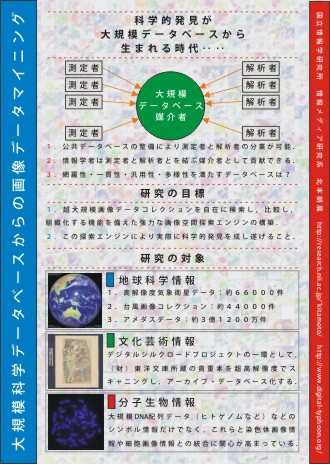| ||||||||
| ||||||||
|
These days, we often heard about "X-informatics", or the name of the research fields with the suffix "informatics," among which the most notable one is "bioinformatics." These fields share the same traits: they all aim at acquiring new viewpoints and models by applying informatics-based approaches to existing fields such as biology. They also share the same methodology: the generation of huge amount of data with the help of advanced sensor and observation technologies, and the fast search and knowledge discovery from large-scale databases.

These days, we often heard about "X-informatics", or the name of the research fields with the suffix "informatics," among which the most notable one is "bioinformatics." These fields share the same traits: they all aim at acquiring new viewpoints and models by applying informatics-based approaches to existing fields such as biology. They also share the same methodology: the generation of huge amount of data with the help of advanced sensor and observation technologies, and the fast search and knowledge discovery from large-scale databases.
In order for this approach to work effectively, we need to have as much data as possible, because the justification of this approach relies on the collection of "fact" that really occurred in the world. If we have more data, then we can draw more reliable conclusion. However, it does not mean that we simply should have more data; moreover, we need to have a data-collecting strategy for collecting many data with high quality,
Another important research issue is the construction of database for managing huge amount of collected data. Bioinformatics may be the most advanced research area in terms of using huge-scale databases as the infrastructure of research. The public databases are collecting sequenced genome data from all over the world, and other researchers access to these databases to download interested data and use them for their own purposes. This kind of research style based on data will be more and more popular in other scientific disciplines.
However, the utilization of computers in scientific disciplines is itself not at all new. Changes unique to recent movement can be described as "From computational-X to X-informatics," or in other words, from simulation technology to database technology. We can compare those two approaches schematically as follow.
Then we can imagine the combination of approaches based on the research on "What is this?", namely X-informatics (database technology), and develop the research on "How this will be?", namely computational-X (simulation technology). This combination, in short, leads to a new scientific approach with the effective combination of observational facts and theoretical predictions. Moreover, if those large amount of data can be shared among many experts using Grid, for example, we many be able to establish a new scientific approach with the effective usage of networks.
A huge database of biological information.
http://www.ncbi.nlm.nih.gov/
The astoronomical survey project by the comprehensive observations of celestial objects.
http://www.sdss.org/
|